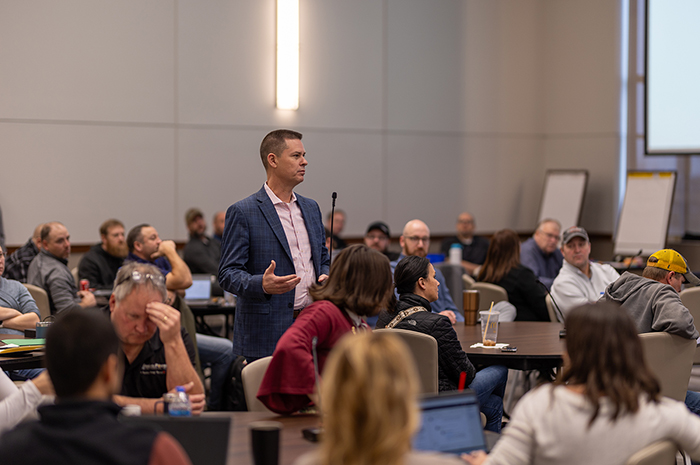The right way to do rights of way
Minnkota is enhancing its power line corridors with vegetation management and conservation programs.
Shawna Setter spent most of her summer and fall outdoors, analyzing branch lengths and talking to landowners about the future of their woody plants. With a background in horticulture and landscaping, she’s been planted in the right place as Minnkota’s new vegetation management specialist.
“I’m obsessed with trees,” she said. “I love trees and shrubs.”
Setter is settling nicely into the position, a first-ever role for Minnkota. The cooperative has had a vegetation management program for decades to help keep trees and other plants from growing into right-of-way corridors – the area underneath and to the sides of high-voltage transmission power lines. However, during a 2023 peer review from the North American Transmission Forum (NATF), a recommendation was made to centralize the vegetation management efforts of several Minnkota departments.
“I think the quote we got was, we built the racecar, we just needed the driver for it,” said Wayne Lembke, Minnkota Engineering Manager for Power Delivery Transmission. “That’s where bringing Shawna in as our vegetation management specialist, who has that specific knowledge on the vegetation that we’re dealing with, can help guide the program a little better.”
Minnkota’s service territory contains more than 3,400 miles of transmission power lines, and that means 3,400 miles of right of way to manage. Minnkota uses an integrated approach to monitoring and maintaining vegetation growth in those corridors, one that not only keeps plants from interfering with the lines but also promotes sustainable plant communities. Mowing, tree pruning or removal, and EPA-approved herbicide application are all used to meet regulatory and environmental compliance.

As vegetation management lead, Setter is streamlining Minnkota’s maintenance cycles to more efficiently use resources and bring costs down. She has a good idea of how fast plants will grow, what trees have large crown spreads, and how to spot a diseased or hazardous tree. When Minnkota and its contractors must trim or remove trees in a right of way running through someone’s land, Setter communicates those intentions directly to work through any apprehensions.
“We’re working with them to make it safe for the transmission line, but aesthetically pleasing for them as well,” she said. “For many landowners, it’s just about having a face that they can talk to. It’s the fact that we care enough that we’re sending a person out there to talk to them, and to understand where they’re coming from as well.”
Every “extra mile” moment adds up. Keeping trees maintained not only reduces outages from branch contacts (whether from unmonitored growth, line sag or storms), but also protects lineworkers and homeowners from direct contacts or fires caused by damaged lines.
“We want to try to reclaim some of our rights of way, continuing to get our corridors to that industry standard,” Lembke said. “We’re making sure we’re improving safety and reliability for our members.”

From trees to flowers
While Setter is out collecting vegetation data in transmission corridors, she’s often flanked by Minnkota Environmental Specialist Kacey Borin, who’s working on a complementary program to conserve nature in the right of way. Her focus, however, is on the pollinators.
Borin is helping Minnkota and its member cooperatives become partners in the Candidate Conservation Agreement with Assurances (CCAA) for the monarch butterfly. This program of the U.S. Fish and Wildlife Service is specific to energy and transportation rights of way, and offers regulatory coverage for those entities who create, enhance and maintain habitats for monarch butterflies, a species that’s vulnerable to landing on the endangered species list.
“Managing hazardous woody vegetation not only establishes safe right of way, but also opens the canopy up for the grasses and forbs that can benefit pollinators like monarchs and bees,” Borin said. “The CCAA then encourages that management to be pollinator-conscious in the meantime. So, the destination for both programs is ultimately the same – it’s the vehicle to get there that can be fine-tuned.”

To create optimal pollinator habitats, Minnkota will focus on incorporating native seed mixes into certain rights of way and removing brush to open up more space for grassland. In some cases, the spaces are already ideal for monarchs, so Minnkota simply needs to maintain them.
Borin says she’s glad Minnkota has arrived at the activation stage of this program, which has been in the works for several years. In the meantime, it has continued to gain support from cooperatives and their members around the region.
“Becoming a part of the CCAA is exciting to see as both a Minnkota employee and as an enthusiast of grassland habitats. This agreement has crafted a uniquely collaborative space for industry, regulation and conservation entities,” she said. “With the data collected from CCAA-required monitoring, we can continue to evolve vegetation management strategies in a way that can be beneficial to pollinators.”
With their combination of fresh insights, Borin and Setter are helping move Minnkota’s rights of way in the right direction.
“Right now, we’re kind of at a ‘try to keep everything away from the line’ point,” Setter said. “Hopefully, we get it to a point where that’s not even an issue, and we can expand on what we want to make the right way, and not just something we don’t want it to be.”
MAIN IMAGE: Minnkota Vegetation Management Specialist Shawna Setter (right) and Environmental Specialist Kacey Borin (left) survey a transmission line right-of-way corridor in rural Grand Forks County, North Dakota. (Minnkota/Michael Hoeft)
...



